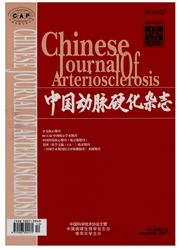

 中文摘要:
中文摘要:
目的探讨白细胞介素10对单核-巨噬细胞源性泡沫细胞转化过程中趋化因子表达的影响及其机制。方法以佛波醇酯诱导THP-1单核细胞分化为巨噬细胞,在氧化型低密度脂蛋白作用下形成泡沫细胞,同时给予白细胞介素10干预,采用逆转录聚合酶链反应和凝胶阻滞试验研究单核细胞趋化蛋白1、巨噬细胞炎性蛋白5、白细胞介素8mRNA的表达变化及白细胞介素10对核因子KB活性的影响。结果在白细胞介素10作用下,泡沫细胞中单核细胞趋化蛋白1和巨噬细胞炎性蛋白5mRNA相对表达量均显著降低,且与作用时间成正相关,而白细胞介素8相对表达量变化不明显。同时白细胞介素10能显著抑制氧化型低密度脂蛋白诱导的核因子KB活化。结论白细胞介素10选择性抑制单核-巨噬细胞源性泡沫细胞形成中趋化因子mRNA的表达与有效地抑制核因子KB活性密切相关。这对降低炎症反应。减少泡沫细胞形成,延缓动脉粥样斑块形成具有重要意义。
 英文摘要:
英文摘要:
Aim To investigate intedeukin-10 (IL-10) affecting chemokine mRNA expression in monocyte-macrophage derived foam cells and its mechanism, Methods Macrophage was induced by phogrbol myristate acetate (PMA) forming THP-1 cell, and then the cells were further stimulated by oxidized low density lipoprotein with or without IL-10. The influence by IL-10 on chemokine mRNA expression was observed by reverse transcription-polymerase chain reaction (RT-PCR) and the nuclear factor-roB (NF-κB) activation was observed by electrophoretic mobility shift assay (EMSA). Results IL-10 could selectively inhibit monocyte chemoattractant protein-1 (MCP-1 ) and macrophage inflammatory protein-5 (MIP-5) mRNA expression. The effects were in dose-dependent fashion. However there was no effect on IL-8 mRNA expression. IL-10 could also significantly inhibit ox-LDL induced NF-κB activation. Conclusions The inhibition on NF-κB activation induced by IL-10 is responsible for decreasing MCP- 1 and MIP-5 mRNA expression. The reduction of chemokine expression at the site of atherosclerotic plaque might cut down inflammatory cells recruitment and reduce the plaque further formation.
 同期刊论文项目
同期刊论文项目
 同项目期刊论文
同项目期刊论文
 期刊信息
期刊信息
